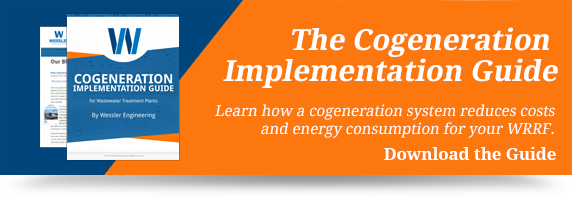
Each year Operators, Engineers, Manufacturer Representatives and more to come together at the Indiana Water Environment Association’s annual conference in Indianapolis to discuss the latest in the world of water, wastewater and stormwater. It provides an opportunity not only to learn, but also to share experiences with others in the water field. Below are our top three takeaways from this year’s conference.
1. Energy Savings Are Out There
Many plants in Indiana utilize aerobic digestion but this is a very energy intensive process. For some plants, aeration accounts for 50% of their energy usage. When a plant switches to anaerobic digestion, energy costs are reduced by eliminating the aeration system’s demand and the gas produced by the digesters can be used in a cogeneration (Co-gen) system to help power the plant. Another way to save on energy is to replace existing equipment with lower horse power alternatives. One example of this would be switching from a centrifuge to a screw or volute dewatering press. Significant energy savings can be seen since a volute with a throughput of 2,650 lbs/hr is only 12.5 horsepower compared to a similarly sized centrifuge which is 50 horsepower. A third way to save energy is to add a variable frequency drive (VFD) to an existing pump. VFDs allow for the pump’s motor to be slowed down or sped up to match the amount of flow that needs to be pumped. This prevents the pump from running at full speed all the time and can reduce energy cost by 10-60%.
2. You May Not Have Adequate Sludge Storage
Often times sludge estimates do not take inert solids into consideration. Inert solids have no effect on the treatment processes but they do take up space. In fact, including these solids in your sludge production calculations can almost double the amount of solids expected per day. With the new phosphorus limits many plants are seeing more solids than ever before. This is because the chemicals that are used for phosphorus removal bind not only to phosphorus but also other components of the wastewater, including metals. In fact, a 30% increase of solids can be expected once chemical phosphorus removal systems are brought online. When inert solids and the increase in solids produced from chemical phosphorus removal are not considered, a plant’s biosolids handling, digestion and storage are all impacted.
3. No Two Sewer Rehabs Are the Same
As existing sewer infrastructure increases in age, the number of rehab projects increases as well. There are many different reasons sewer rehab may be needed as well as a variety of rehab methods. The type of sewer defect, the size and material of the sewer, accessibility, and project budget all need to be considered when determining if rehab is an option and if so, what method should be used. Three of the more prominent rehab methods are Cured-in-Place Pipe (CIPP), fold and form, and shotcrete. CIPP and shotcrete are ideal for larger diameter while fold in form has proved to be successful in smaller sewers. Each sewer rehab project is different and comes with its own unique constraints. For example, if a utility encounters a badly deteriorated sewer that has lost its structural integrity, this would be a suitable application for CIPP; CIPP liners are designed to be independently structurally strong and do not rely on the host pipe for any structural strength contribution. However, if man entry is feasible and pumping bypass is a concern, shotcrete would be a good option. No one method is right for every situation and it is important to take all the necessary factors into consideration before choosing the best sewer rehab method for a specific project.
Although the next IWEA annual conference isn’t until August 2018, there are plenty of other education opportunities throughout the year. IWEA’s next event is the Monticello Lunch and Learn & Plant Tour on September 19th. The event will cover the basics of biological nutrient removal and showcase the recently completed plant upgrade at the Monticello WWTP that was designed by Wessler. We hope to see you there!
Tags

